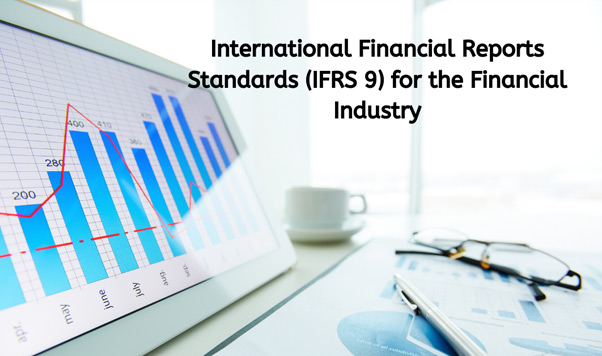International Financial Reports Standards (IFRS 9) for the Financial Industry
Updated On : September 2019
It is believed that one of the key reasons for the onset of the financial crisis of 2008 was the approach banks took to determine losses on bad loans. Banks' policies were as per the earlier IAS 9 guidelines, which had severe shortcomings. International Financial Reports Standards (IFRS 9) was introduced by the International Accounting Standards Board's (IASB) to counter this crisis, and address the accounting for financial instruments. It replaced IAS 9 with a single integrated standard and came into effect from January 1, 2018.
According to the IFRS and IASB, following are the requirements of the IFRS 9 standard :
-
IFRS 9 Classification & Measurement
Classification refers to the way financial assets and financial liabilities are accounted for in financial statements, particularly in the way they are measured on an ongoing basis. For the classification of financial assets, IFRS 9 brought in a logical integrated approach driven by cash flow characteristics and the business model in which an asset is held. It is a single impairment model applied to all financial instruments.
-
IFRS 9 Impairment
During the financial crisis, the delayed recognition of credit losses on loans and other financial instruments were linked to weak accounting standards. With IFRS 9, the IASB's new expected-loss impairment model mandated more timely recognition of expected credit losses. The new standard asked for entities to account for expected credit losses from the moment when financial instruments are first identified. IFRS 9 acknowledges the full lifetime expected losses on a more regular basis.
-
IFRS 9 Hedge Accounting
IFRS 9 introduced a significantly enhanced model for hedge accounting, with improved disclosures about risk management activity. The model helps to align accounting treatment with risk management activities, and allows entities to better reflect all these activities in their financial statements. Also, because of these changes, users of the financial statements are provided with better information about risk management and the effect of hedge accounting in their financial statements.
Following are the key changes brought in by IFRS 9 :
- IFRS 9 brought in an 'expected loss' impairment standard that made it necessary for banks to provide more timely recognition of expected credit losses (ECL), based on future expectations. Banks have to make forward-looking provisions for credit losses in their balance sheet and income statements, for all financial instruments.
- IFRS 9 also requires banks to account for ECL on an individual financial instrument level from the moment instruments are first recognized, and not when the default or loss happens. IFRS 9 needs banks to put aside a significantly higher amount to protect losses.
- IFRS 9 identifies two ways of determining a loss allowance or a provision for a financial instrument :
- Collective assessment of financial instruments which include those assessed on a group or portfolio basis, with shared risk characteristics
- Individual assessment of loans consisting of instruments that are assessed on a specific basis and have been identified as impaired or non-performing
- Under IFRS 9, banks are required to classify all financial instruments into any of the following three categories
- Amortized cost
- Air value through comprehensive income (FVOCI)
- Air value through profit and loss (FVPTL).
- Under IFRS 9, banks are also required to assign a stage to each account that has been classified for amortized cost or FVOCI. Stage assignment is according to the account's credit risk characteristics.
- IFRS 9 gives almost accurate detailed guidelines on the calculation of items like the effective interest rate (EIR), the credit-adjusted effective interest rate, the effective interest spread (EIS); and the expected credit loss (ECL), based on forward-looking assessments.
- Banks are using a progressive approach in estimating point-in-time probability default (PD) and loss-given default (LGD) for provision calculations. Banks are also building and calibrating point-in-time models, which require a lot of effort.
-
Reporting
After banks make all calculations on an account level granularity, they need to be able to report and analyse not just point-in-time data but also trends in however the provisions have evolved across all accounts.
- Banks have to institute an acceptable knowledge governance program to originate and supply quality knowledge at an extremely granular level, for IFRS 9 processing. They need to think about historical, current, and advanced forecasts in numerous areas for ECL computations.
Hence, it is important to look for a solution which can
- Handle archival from retired or migrated applications
- Support data purging
- Provide standard reports, MIS, user logs
- Facilitate queries on archived data
Leave Comments :
Latest Blog
-
 How Lending Solutions for Personal Loans Ensure Regulatory Compliance Updated
On : September 2025
How Lending Solutions for Personal Loans Ensure Regulatory Compliance Updated
On : September 2025
-
 Lending Software for Auto Loans: 9 Must‑Have Features Updated
On : August 2025
Lending Software for Auto Loans: 9 Must‑Have Features Updated
On : August 2025
-
 Scaling Multi-Product Retail Lending with Unified Lending Management Software Updated
On : August 2025
Scaling Multi-Product Retail Lending with Unified Lending Management Software Updated
On : August 2025
-
 The Impact of Lending Software on NBFCs’ Turnaround Time and Customer Experience Updated
On : August 2025
The Impact of Lending Software on NBFCs’ Turnaround Time and Customer Experience Updated
On : August 2025
-
 How Lending Management System Trends Are Shaping the Future of Retail Lending? Updated
On : August 2025
How Lending Management System Trends Are Shaping the Future of Retail Lending? Updated
On : August 2025



Comments :
Thanks to you"